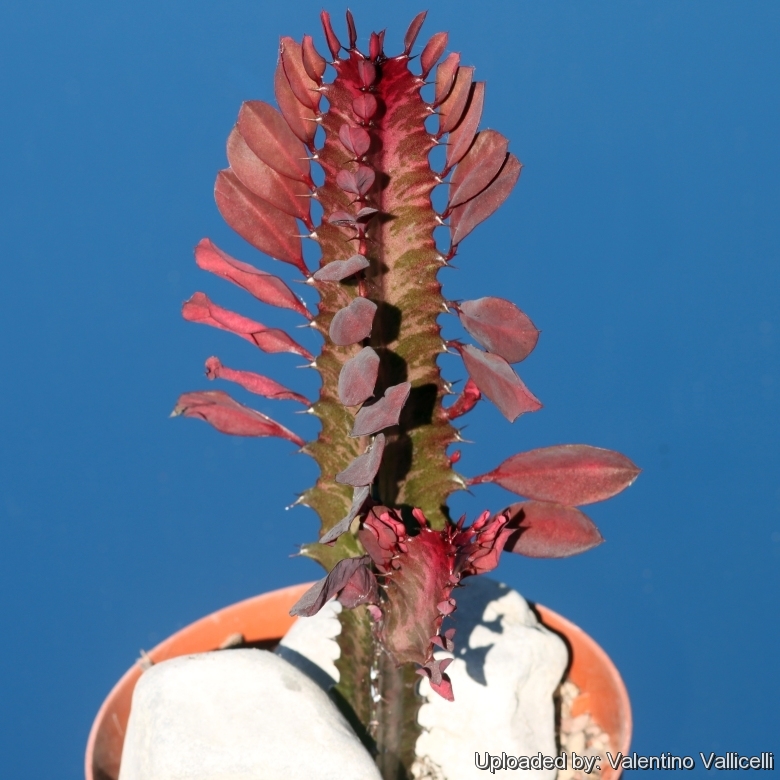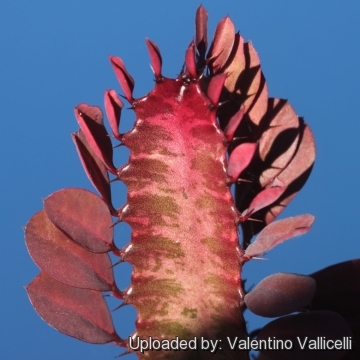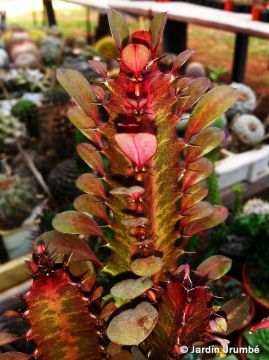




Your support is critical to our success.

Origin and Habitat: Euphorbia trigonaSN|27172]]SN|27172]] is commonly planted in Central Africa, Angola, Malawi and Gabon. It is also used for hedging in tropical zones, or as an ornamental elsewhere. It is possibly of hybrid origin, as it is only known in cultivation and is not known to flower. The type was said to be from India, but the probable origin is more likely to have been Angola.
Synonyms:
Euphorbia trigona Mill.
Gard. Dict., ed. 8. 3 1768.
Synonymy: 2
- Euphorbia trigona Mill.
ENGLISH: African milk tree, cathedral cactus, Abyssinian euphorbia, high chaparall
DANISH (Dansk): Trekantsøjle, Cowboy-kaktus
GERMAN (Deutsch): Dreikantige Wolfsmilch
Description: Euphorbia trigonaSN|32500]]SN|27172]] is a tender, evergreen, succulent succulent plant occasionally known (especially in older literature) as Euphorbia hermentianaSN|27172]]SN|32502]]. The stems have three wing-like angles and carry short, sharp spines as well as leaves. Eventually the plant grows into a densely and compactly branched erect shrub or small tree of two metres or more. Euphorbia trigonaSN|32500]]SN|27172]] is widely cultivated as a pot plant. There exists also an attractive cultivated variant Euphorbia trigona cv. Royal RedSN|27172]]SN|32500]] (Euphorbia trigonaSN|32502]]SN|27172]] 'rubra') with stems and leaves flushed purplish-red (and some bronzish-green). The leaves are often darker red in this clone and the stems greener for a lovely bicolored look. The stems can be flecked red to magenta. Some leaves may become rich magenta-red. Speciality growers may also offer crested or fasicated material.
Derivation of specific name: “trigonus, -a, -um,” from the Greek adjective “τριγωνοϛ” 3 angled, in allusion to the triangular branches.
Stem: Strictly erect, closely packed, 3- to 4-angled, 4 - 6 cm in diameter, indistinctly constricted into oblong segments to 10-25 cm long, 4 to 6 cm in diameter more or less woody at the base of the plant. The branches are dark green variegated with V-shaped light green patterns (bronzish-green to purple red in cv. Royal Red). The angles are more or less winged, with prominent teeth 1 cm apart.
Stipular spines: Paired, reddish-brown, later dark, 5 - 6 mm long.
Leaves: Borne along the branch ribs on the new growth from between the two thorns on each ridge, lanceolate to drop-shaped, varying from 7 to 9 mm and deciduous, to 3-5 cm and more persistent. Usually the leaves die off in winter, but in exceptional cases (no direct sunlight) they may last for several years. The plant will produce new leaves in spring. In the frequently encountered Euphorbia trigona cv. Royal RedSN|27172]]SN|32500]] the leaves may become rich magenta-red.
Flowers: The plant has never been known to flower.
Subspecies, varieties, forms and cultivars of plants belonging to the Euphorbia trigona group
Bibliography: Major references and further lectures
1) Laurence C. Hatch “HITS: House, Interior, Tropical, and Succulent Plants: Genera D to E” Laurence Hatch Press, 13 March 2015
2) Gabriella Harriet Schmelzer, Ameenah Gurib-Fakim “Medicinal Plants”, Volume 1 PROTA, 2008
3) Nico Vermeulen, Richard Rosenfeld “Encyclopedia of House Plants” Taylor & Francis, 1999
4) Urs Eggli “Illustrated Handbook of Succulent Plants: Dicotyledons” Springer Science & Business Media, 2002
5) James Cullen, Sabina G. Knees, H. Suzanne Cubey. “The European Garden Flora Flowering Plants: A Manual for the Identification of Plants Cultivated in Europe, Both Out-of-Doors and Under Glass.” Cambridge University Press, 2011.
6) Wikipedia contributors. "Euphorbia trigona." Wikipedia, The Free Encyclopedia. Wikipedia, The Free Encyclopedia, 31 Oct. 2015. Web. 5 Feb. 2016.
7) Philip Miller: "The gardeners dictionary" 3, 8th edition, J. + F. Rivington, London 1768.
8) Daryl Koutnik: “Euphorbia trigona Miller ... or is it? E. hermentiana Lemaire?” In: The Euphorbia Journal. volume 7, page 11-14. Strawberry Press, 1991,
9) Volker Buddensiek “Sukkulente Euphorbien” Ulmer, Stuttgart 1998
10) Jezek & Kunte “Enciclopedia delle piante grasse,” Vercelli, White Star, 2006
11) “Dictionary of Botanical Epithets” , Retrieved 03 January 2016, from <http://www.winternet.com/~chuckg/dictionary/dictionary.180.html

Euphorbia trigona cv. Royal Red Photo by: Valentino Vallicelli

Euphorbia trigona cv. Royal Red Photo by: Alexander Arzberger
Cultivation and Propagation: Euphorbia trigona cv. Royal RedSN|32500]]SN|32500]] is an easy species to grow that is suited for any well drained soil in full sun. It grows well when there is a layer of brick and charcoal pieces, on top of which sandy loam soil is spread. It needs no maintenance. But young plant are happy growing indoors, eventually the plant grows into a freely-branching giant of 2m or more; it is then usually thrown away.
Growth rate: It is a moderately fast grower, and will quickly become large landscape masterpieces in just 3-5 years. Only downside is from strong winds, the columns often smash into each other, causing permanent scarring... best to plant in such a location where winds are not a big issue. It is a long lived plant and once established, it will be content in its position and with its soil for years.
Soil: Give the plant an airy growing medium which mainly consists of non organic material such us clay, pumice, lava grit, and only a little peat or leaf-mould.
Transplanting: Like quite small pots, repott in very later winter, early spring.
Water requirements: Water regularly during the active growing season from March to September. No water should ever be allowed to stand around the roots. Keep almost completely dry in winter.
Light requirements. It can tolerate moderate shade, and a plant that has been growing in shade should be slowly hardened off before placing it in full sun as the plant will be severely scorched if moved too suddenly from shade into sun.
Maintenance: Can be pruned for shape and branching.
Hardiness: Frost tender, care should be taken to keep it warm in winter and ensure a minimum temperature of 10° C.
Plant Pests: Prone to mealy bugs and rarely scale.
Propagation: Try to propagate it instead by cutting off young shoots at their base (make sure the latex does not come into contact with mouth. eyes or skin). Wash the latex off the cuttings, let them dry for a few days and stuff them in mildly moist, warm compost.
Warning: All Euphorbias contain a white sap that can be irritating to eyes and mucous membranes. If contact is made with this white sap, take care to not touch face or eyes before washing hands with soap and water.
Uses: The plant is used in parks and gardens for ornamentals and also for protective hedges, due to the fragility of its branches together with the well known skin irritancy of its latex. It can also be kept as an indoor ornamental plant.
Traditional uses: E. trigona is commonly planted as a ritual plant and hedge near vilages, especially in Gabon, Central Africa, Angola and Malawi. The latex is an additive to Periploca nigrescens Afzel. arrow poison, and is also used as fish poison or as a criminal poison. The latex is also used during trials by ordeal. In Congo some drops of latex in palm wine are taken in severe cases of constipation or in case of an epileptic attack
| Your Actions | |
|---|---|
| Back to Euphorbia index | |
| Back to Euphorbiaceae index | |
 |
Back to Succulents Encyclopedia index |
Privacy stantement - Terms and conditions - How to cite - About us - Feedback - Donate



